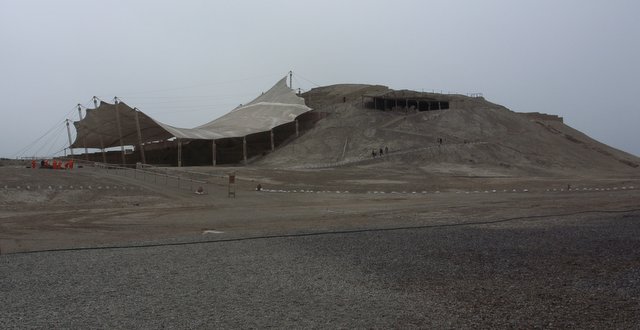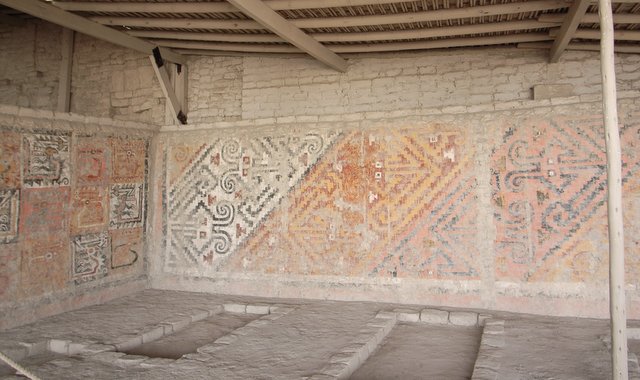
General view of the temple of Cao Viejo at El Brujo
After scattering the ashes, we drove south on the Pan-American highway for about three hours to a temple complex at El Brujo (The Witchdoctor) where some very interesting discoveries had been made in 2006 which the archaeologists are still getting to grips with.
The first part of the visit was interesting enough. You can see from the picture above that there is a sail-like protective roof over the excavated side of the temple platform. This is because the archaeologists discovered some stunning reliefs adorning the wall of the temple.

Naked prisoners, roped together and about to be ritually slaughtered
This is a frieze showing a procession of warriors who have just been defeated in ritual combat – a bit like a gladiatorial contest in Ancient Rome. They have been stripped naked, tied together with a rope around their necks, and are being marched off to be ritually slaughtered. Talk about blood-thirsty!
But, although that was very impressive, it is not unique. It is apparently the standard way that the Moche people decorated their temples, between the first and eighth centuries AD. Later in the week I saw another temple decorated in much the same way. What really surprised the archaeologists was what they discovered near the top of the temple platform, now protected by the second roof at the right in the top picture.

The burial chamber at the temple of Cao Viejo
This was a stunningly-decorated burial chamber with a main burial (just off the edge of the picture to the bottom left) and four subsidiary burials – three of adults (two of which you can see above) and one of a child (just visible in the bottom left corner). The date was the same as one of the earlier burials from Sipán (known as the Old Lord of Sipán), i.e about AD300. The grave goods were very comparable to those of the Old Lord too – golden nose rings, gold crowns/headdresses, necklaces of gold, silver and precious stones, and a gold-encrusted tunic. Clearly, this was the grave of the ruler of the valley of the Rio Chicama.
But there were a few anomalies that puzzled the archaeologists. For a start, all of the adults who were sacrificed to join their ruler in the afterlife were male, apparently priests and warriors – there were no wives or concubines found. The body was wrapped in many metres of finely woven cotton fabric, which the archaeologists painstakingly unwrapped. Then they got the shock of their professional lives. For inside the wrappings wasn’t a lord at all – it was the mummified body of a tiny woman (only 1.48m, 4’10” tall) aged about 20-25, who apparently died in childbirth. She has been named the Lady of Cao. Until her discovery, the (predominately male) archaeologists had always assumed that only men could rule in pre-Inca Peru. And that is despite a line in one of the chronicles written by the Spanish Conquistadors saying that this particular region of Peru was traditionally matriarchal. Now they are having to rethink their ideas and rewrite the text-books to encompass the idea that women could and did rule significant areas in pre-Inca Peru.
As we left the temple complex, my guide asked me what I felt, as a woman, about the fact that the Lady of Cao had been the ruler of the district? As a somewhat strident feminist, I had only one word in reply – “YES!!!!“
